Enhancing Bi2Te2.70Se0.30 Thermoelectric Module Performance through COMSOL Simulations
Abstract
:1. Introduction
2. Materials and Methods
3. Results and Discussion
4. Conclusions
Author Contributions
Funding
Data Availability Statement
Acknowledgments
Conflicts of Interest
References
- Shastri, S.S.; Pandey, S.K. Theory of Energy Conversion between Heat and Electricity. Thermoelectr. Adv. Thermoelectr. Mater. 2021, 2, 21–53. [Google Scholar] [CrossRef]
- Yan, Q.; Kanatzidis, M.G. High-Performance Thermoelectrics and Challenges for Practical Devices. Nat. Mater. 2022, 21, 503–513. [Google Scholar] [CrossRef] [PubMed]
- Zhou, C.; Lee, Y.K.; Yu, Y.; Byun, S.; Luo, Z.-Z.; Lee, H.; Ge, B.; Lee, Y.-L.; Chen, X.; Lee, J.Y.; et al. Polycrystalline SnSe with a Thermoelectric Figure of Merit Greater than the Single Crystal. Nat. Mater. 2021, 20, 1378–1384. [Google Scholar] [CrossRef]
- Twaha, S.; Zhu, J.; Yan, Y.; Li, B. A Comprehensive Review of Thermoelectric Technology: Materials, Applications, Modelling and Performance Improvement. Renew. Sustain. Energy Rev. 2016, 65, 698–726. [Google Scholar] [CrossRef]
- Li, D.; Li, J.M.; Li, J.C.; Wang, Y.S.; Zhang, J.; Qin, X.Y.; Cao, Y.; Li, Y.S.; Tang, G.D. High Thermoelectric Performance of N-Type Bi2Te2.7Se0.3via Nanostructure Engineering. J. Mater. Chem. A 2018, 6, 9642–9649. [Google Scholar] [CrossRef]
- Mamur, H.; Bhuiyan, M.R.A. Characterization of Bi2Te3 Nanostructure by Using a Cost Effective Chemical Solution Route. Iran. J. Chem. Chem. Eng. 2020, 39, 23–33. [Google Scholar] [CrossRef]
- Bhuiyan, M.; Mamur, H.; Dilmaç, Ö. A Review on Performance Evaluation of Bi2Te3-Based and Some Other Thermoelectric Nanostructured Materials. Curr. Nanosci. 2021, 17, 423–446. [Google Scholar] [CrossRef]
- Mamur, H.; Üstüner, M.A.; Dilmaç, Ö.F.; Bhuiyan, M.R.A. Performance Evaluation of Bi2Te3-XSex (0.10 ≤ X ≤ 1.80) Thermoelectric Nanostructured Materials. Clean. Chem. Eng. 2022, 4, 100063. [Google Scholar] [CrossRef]
- Mamur, H.; Üstüner, M.A.; Korucu, H.; Bhuiyan, M.R.A. A Review of the Performance Evaluation of Thermoelectric Nanostructure Materials Bi2-XSbxTe3 (0.20 ≤ X ≤ 1.80). Clean. Chem. Eng. 2023, 6, 100101. [Google Scholar] [CrossRef]
- Bhuiyan, M.R.A.; Korucu, H.; Mamur, H.; Haque, M.M. Growth and Characterization of Bi2Te2.70Se0.30 Nanostructured Materials by Using a Cost-Effective Chemical Solution Route. J. Alloys Metall. Syst. 2023, 4, 100032. [Google Scholar] [CrossRef]
- Demir, M.E.; Dincer, I. Performance Assessment of a Thermoelectric Generator Applied to Exhaust Waste Heat Recovery. Appl. Therm. Eng. 2017, 120, 694–707. [Google Scholar] [CrossRef]
- Aridi, R.; Faraj, J.; Ali, S.; Lemenand, T.; Khaled, M. Thermoelectric Power Generators: State-of-the-Art, Heat Recovery Method, and Challenges. Electricity 2021, 2, 359–386. [Google Scholar] [CrossRef]
- Li, W.; Paul, M.C.; Montecucco, A.; Siviter, J.; Knox, A.R.; Sweet, T.; Gao, M.; Baig, H.; Mallick, T.K.; Han, G.; et al. Multiphysics Simulations of Thermoelectric Generator Modules with Cold and Hot Blocks and Effects of Some Factors. Case Stud. Therm. Eng. 2017, 10, 63–72. [Google Scholar] [CrossRef]
- Sahin, A.Z.; Yilbas, B.S. The Thermoelement as Thermoelectric Power Generator: Effect of Leg Geometry on the Efficiency and Power Generation. Energy Convers. Manag. 2013, 65, 26–32. [Google Scholar] [CrossRef]
- Şişik, B.; LeBlanc, S. The Influence of Leg Shape on Thermoelectric Performance under Constant Temperature and Heat Flux Boundary Conditions. Front. Mater. 2020, 7, 595955. [Google Scholar] [CrossRef]
- Xu, H.; Zhang, Q.; Yi, L.; Huang, S.; Yang, H.; Li, Y.; Guo, Z.; Hu, H.; Sun, P.; Tan, X.; et al. High Performance of Bi2Te3-Based Thermoelectric Generator Owing to Pressure in Fabrication Process. Appl. Energy 2022, 326, 119959. [Google Scholar] [CrossRef]
- Jouhara, H.; Żabnieńska-Góra, A.; Khordehgah, N.; Doraghi, Q.; Ahmad, L.; Norman, L.; Axcell, B.; Wrobel, L.; Dai, S. Thermoelectric Generator (TEG) Technologies and Applications. Int. J. Thermofluids 2021, 9, 100063. [Google Scholar] [CrossRef]
- Luo, Y.; Li, L.; Chen, Y.; Kim, C.N. Influence of Geometric Parameter and Contact Resistances on the Thermal-Electric Behavior of a Segmented TEG. Energy 2022, 254, 124487. [Google Scholar] [CrossRef]
- Wilhelmy, S.; Zimare, A.; Lippmann, S.; Rettenmayr, M. A Temperature Gradient Evaluation Method for Determining Temperature Dependent Thermal Conductivities. Meas. Sci. Technol. 2021, 32, 105601. [Google Scholar] [CrossRef]
- Zhang, W.; Liu, X.; Tian, Z.; Zhang, Y.; Li, X.-J.; Song, H. High Thermoelectric Performance of Large Size Bi2Te2.7Se0.3 Alloy Ingots. J. Electron. Mater. 2023, 52, 6682–6689. [Google Scholar] [CrossRef]
- Saberi, Y.; Sajjadi, S.A.; Mansouri, H. Comparison of Thermoelectric Properties of Bi2Te3 and Bi2Se0·3Te2.7 Thin Film Materials Synthesized by Hydrothermal Process and Thermal Evaporation. Ceram. Int. 2021, 47, 11547–11559. [Google Scholar] [CrossRef]
- Saberi, Y.; Sajjadi, S.A. A Comprehensive Review on the Effects of Doping Process on the Thermoelectric Properties of Bi2Te3 Based Alloys. J. Alloys Compd. 2022, 904, 163918. [Google Scholar] [CrossRef]
- Chen, X.; Yang, Z.; Yu, W.; Wang, R. Modeling and Experimental Study of a BiSbTeSe-Based Thermoelectric Module for Thermal Energy Recovery. J. Electron. Mater. 2020, 49, 3039–3051. [Google Scholar] [CrossRef]
- Teffah, K.; Zhang, Y.; Mou, X. Modeling and Experimentation of New Thermoelectric Cooler–Thermoelectric Generator Module. Energies 2018, 11, 576. [Google Scholar] [CrossRef]
- Högblom, O.; Andersson, R. Analysis of Thermoelectric Generator Performance by Use of Simulations and Experiments. J. Electron. Mater. 2014, 43, 2247–2254. [Google Scholar] [CrossRef]
- Hasan, M.K.; Haque, M.M.; Üstüner, M.A.; Mamur, H.; Bhuiyan, M.R.A. Optimizing the performance of Bi2Te3 TECs through numerical simulations using COMSOL multiphysics. J. Alloys Metall. Syst. 2024, 5, 100056. [Google Scholar] [CrossRef]
- Maduabuchi, C.; Lamba, R.; Ozoegwu, C.; Njoku, H.O.; Eke, M.; Gurevich, Y.G.; Ejiogu, E.C. Thomson Effect and Nonlinear Performance of Thermoelectric Generator. Heat Mass Transf. 2022, 58, 967–980, Erratum in Heat Mass. Transf. 2022, 58, 1027. [Google Scholar] [CrossRef]
- Williams, N.P.; Power, J.; Trimble, D.; O’Shaughnessy, S.M. An Experimental Evaluation of Thermoelectric Generator Performance under Cyclic Heating Regimes. Heat Mass Transf. 2022. [Google Scholar] [CrossRef]
- Crane, D.; LaGrandeur, J.; Jovovic, V.; Ranalli, M.; Adldinger, M.; Poliquin, E.; Dean, J.; Kossakovski, D.; Mazar, B.; Maranville, C. TEG On-Vehicle Performance and Model Validation and What It Means for Further TEG Development. J. Electron. Mater. 2013, 42, 1582–1591. [Google Scholar] [CrossRef]
- Sathiyamoorthy, S.; Kumar, R.; Neppolian, B.; Samiappan, D.; Singh, S.P.; Roy, S.; Dwivedi, N.; Veluswamy, P. Comprehensive Study and Realizing an Enhanced Efficiency of the Thermoelectric Generator Along with Its Thermomechanical Properties. J. Electron. Mater. 2021, 50, 1726–1734. [Google Scholar] [CrossRef]
- De Boor, J.; Müller, E. Data Analysis for Seebeck Coefficient Measurements. Rev. Sci. Instrum. 2013, 84, 065102. [Google Scholar] [CrossRef]
- Zhang, L.; Chen, X.; Sun, J.; Cai, H.; Li, H.; Cui, D. Development of Seebeck Coefficient Measurement System with Wide Range of Temperatures for Inorganic Material Measurement. In Proceedings of the 2015 IEEE 10th International Conference on Intelligent Sensors, Sensor Networks and Information Processing, ISSNIP 2015, Singapore, 7–9 April 2015. [Google Scholar] [CrossRef]
- Wudil, Y.S. Ensemble Learning-Based Investigation of Thermal Conductivity of Bi2Te2.7Se0.3-Based Thermoelectric Clean Energy Materials. Results Eng. 2023, 18, 101203. [Google Scholar] [CrossRef]
- Malik, I.; Srivastava, T.; Surthi, K.K.; Gayner, C.; Kar, K.K. Enhanced Thermoelectric Performance of N-Type Bi2Te3 Alloyed with Low Cost and Highly Abundant Sulfur. Mater. Chem. Phys. 2020, 255, 123598. [Google Scholar] [CrossRef]
- Yoshihama, H.; Kaneko, H. Design of Thermoelectric Materials with High Electrical Conductivity, High Seebeck Coefficient, and Low Thermal Conductivity. Anal. Sci. Adv. 2021, 2, 289–294. [Google Scholar] [CrossRef]

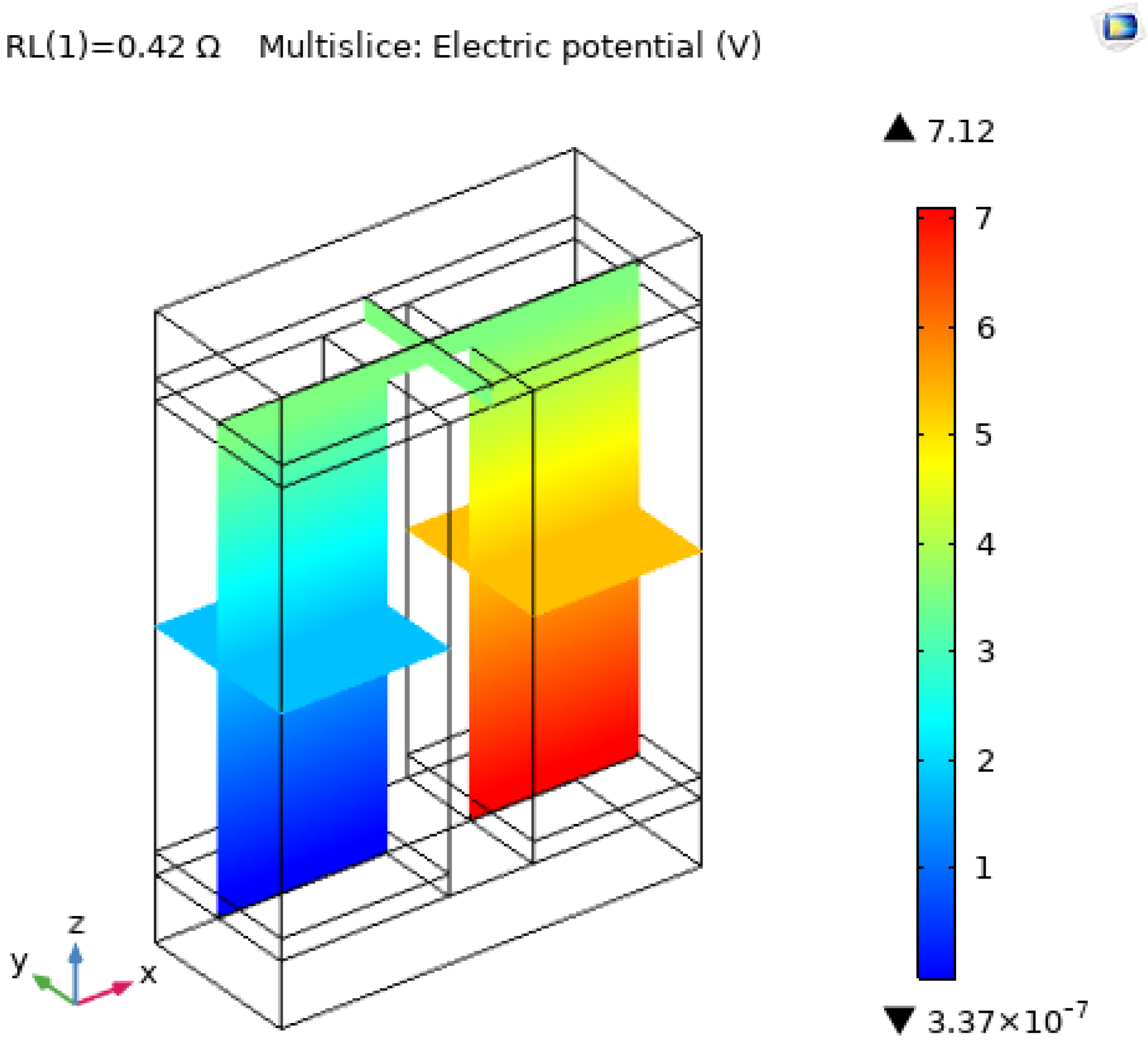

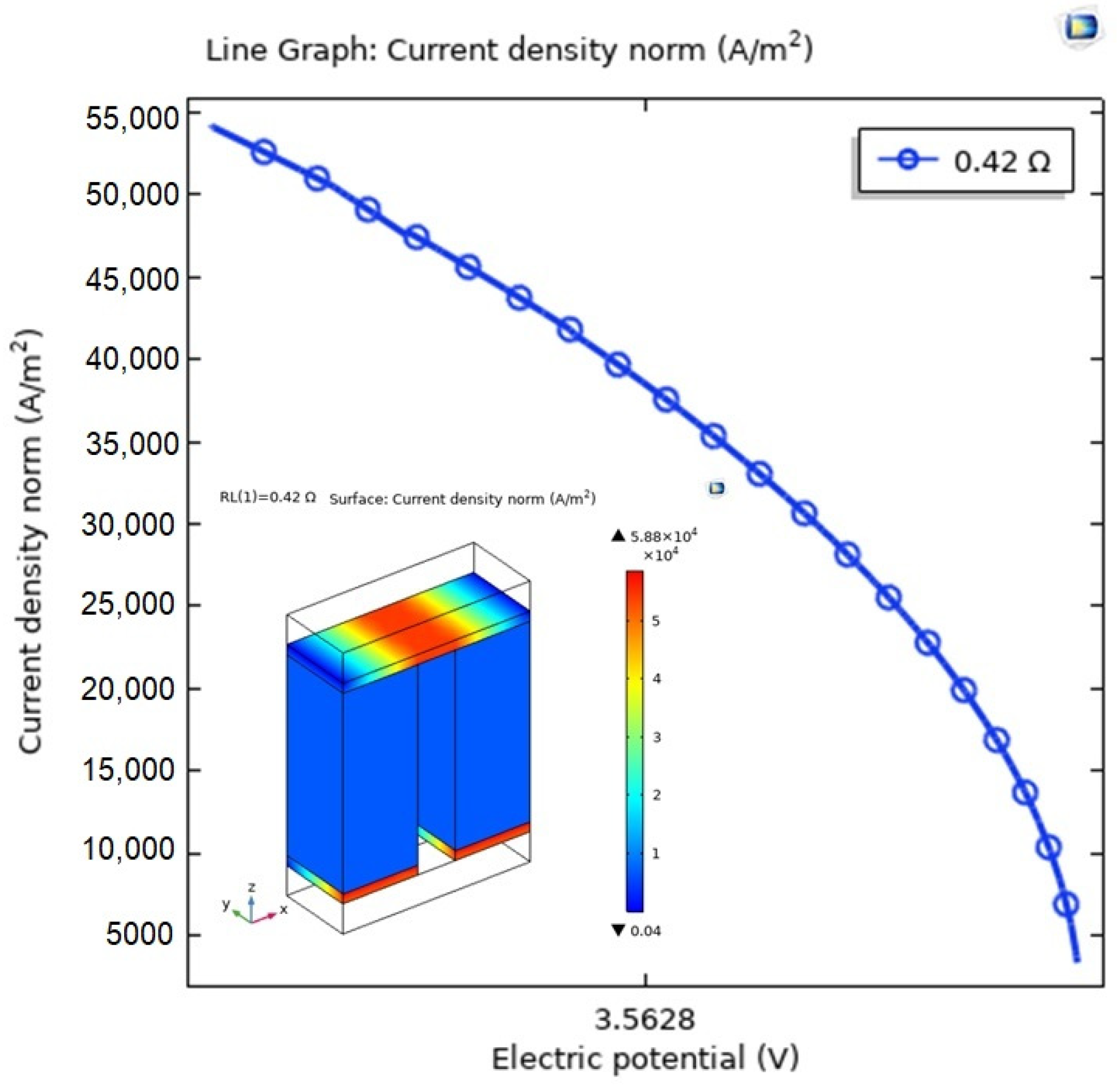
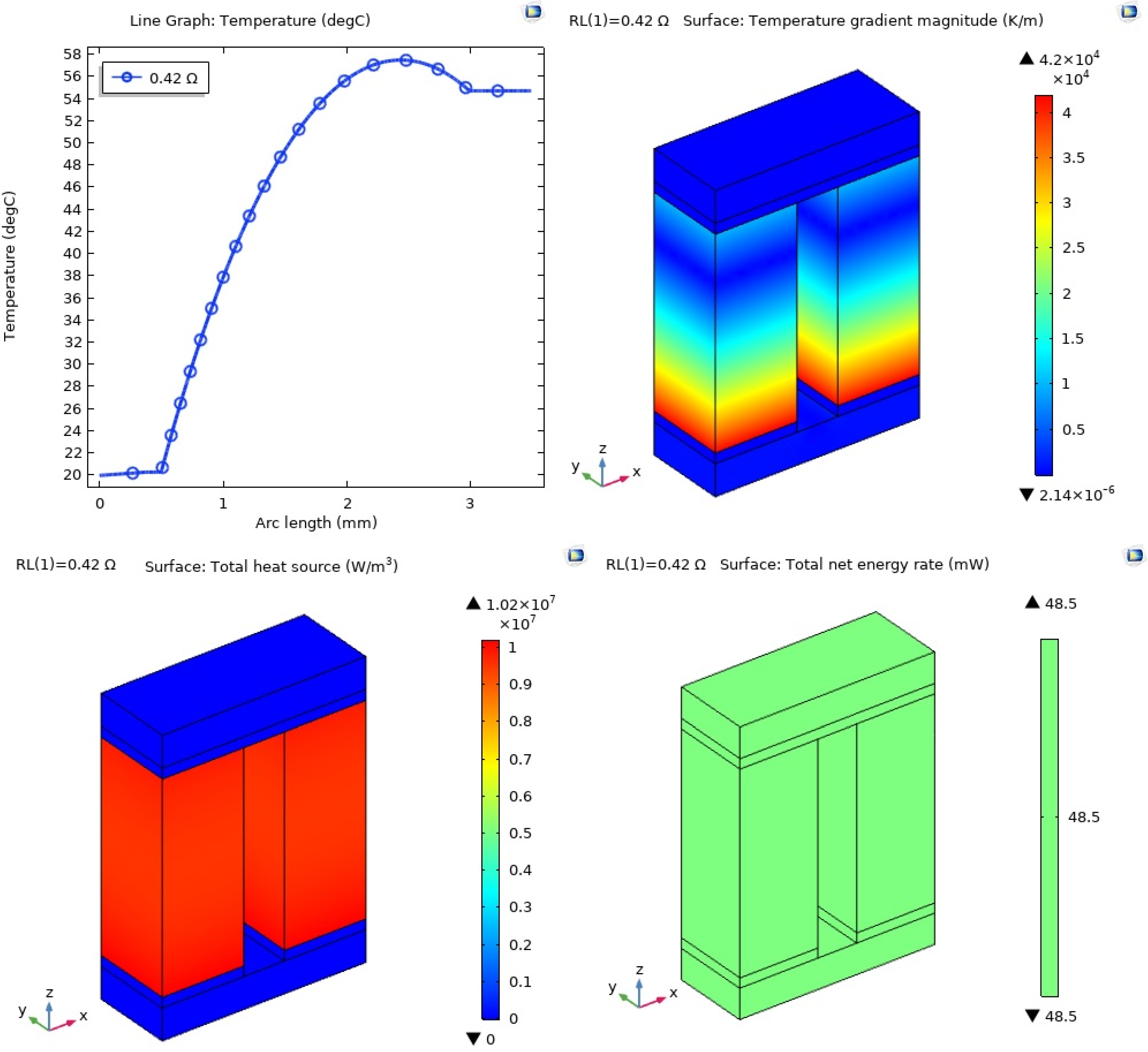
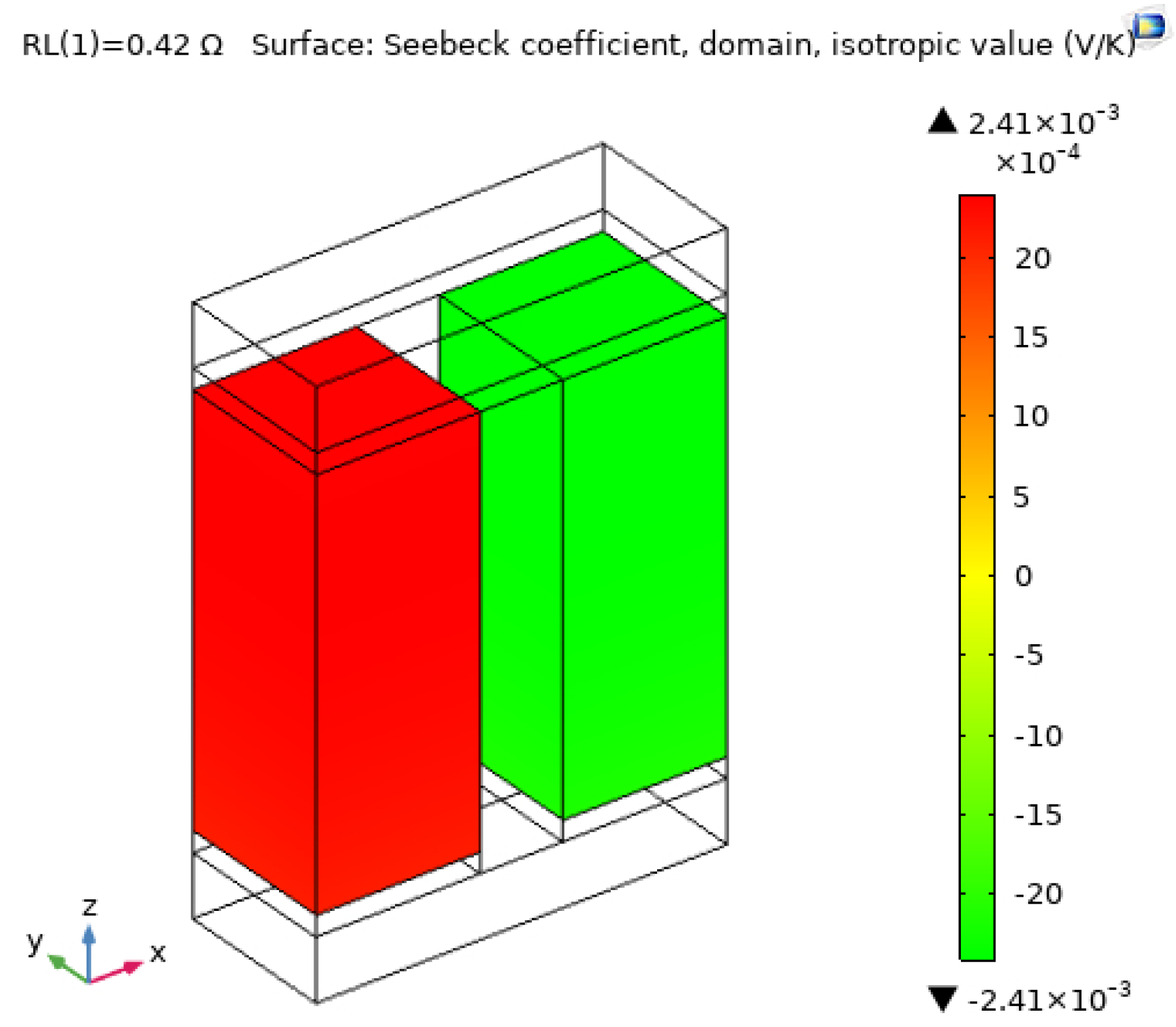
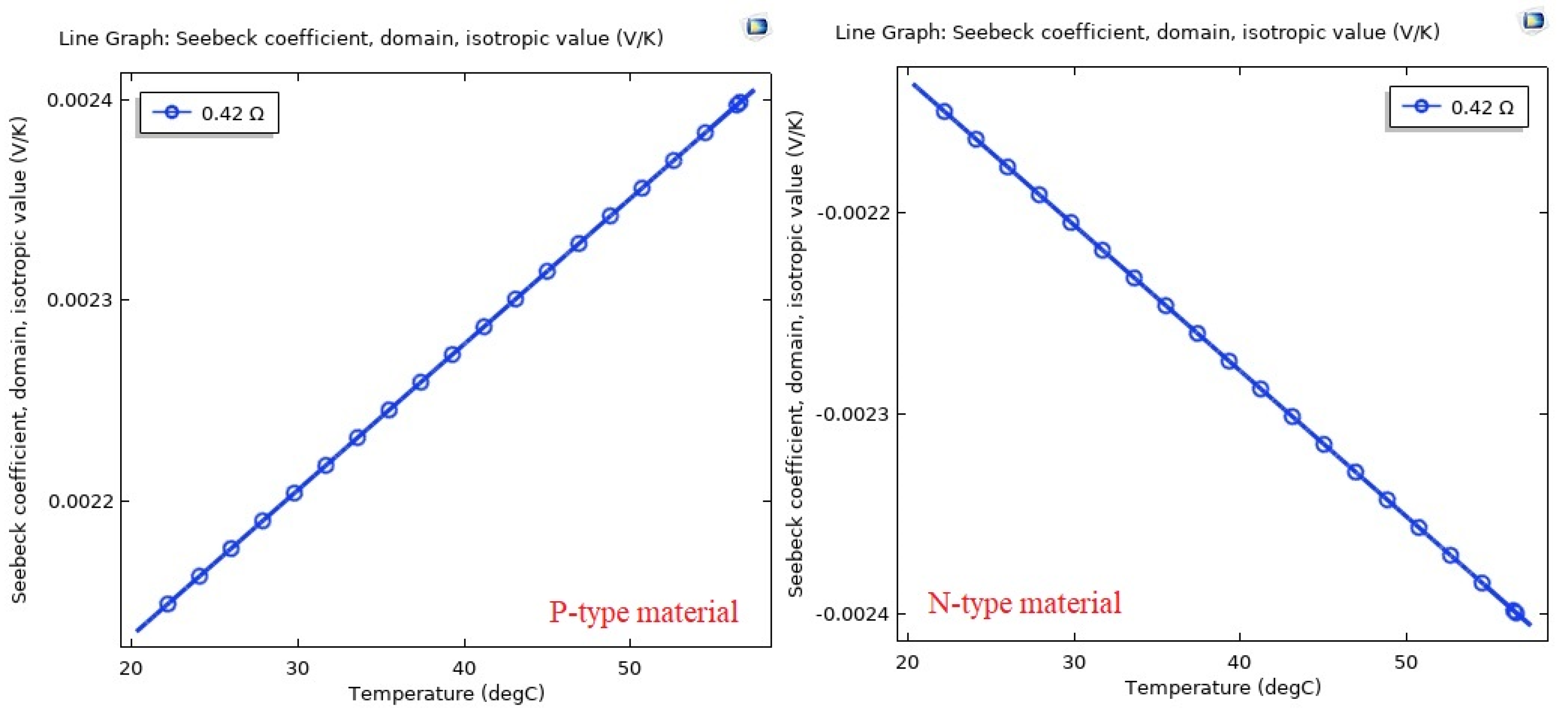
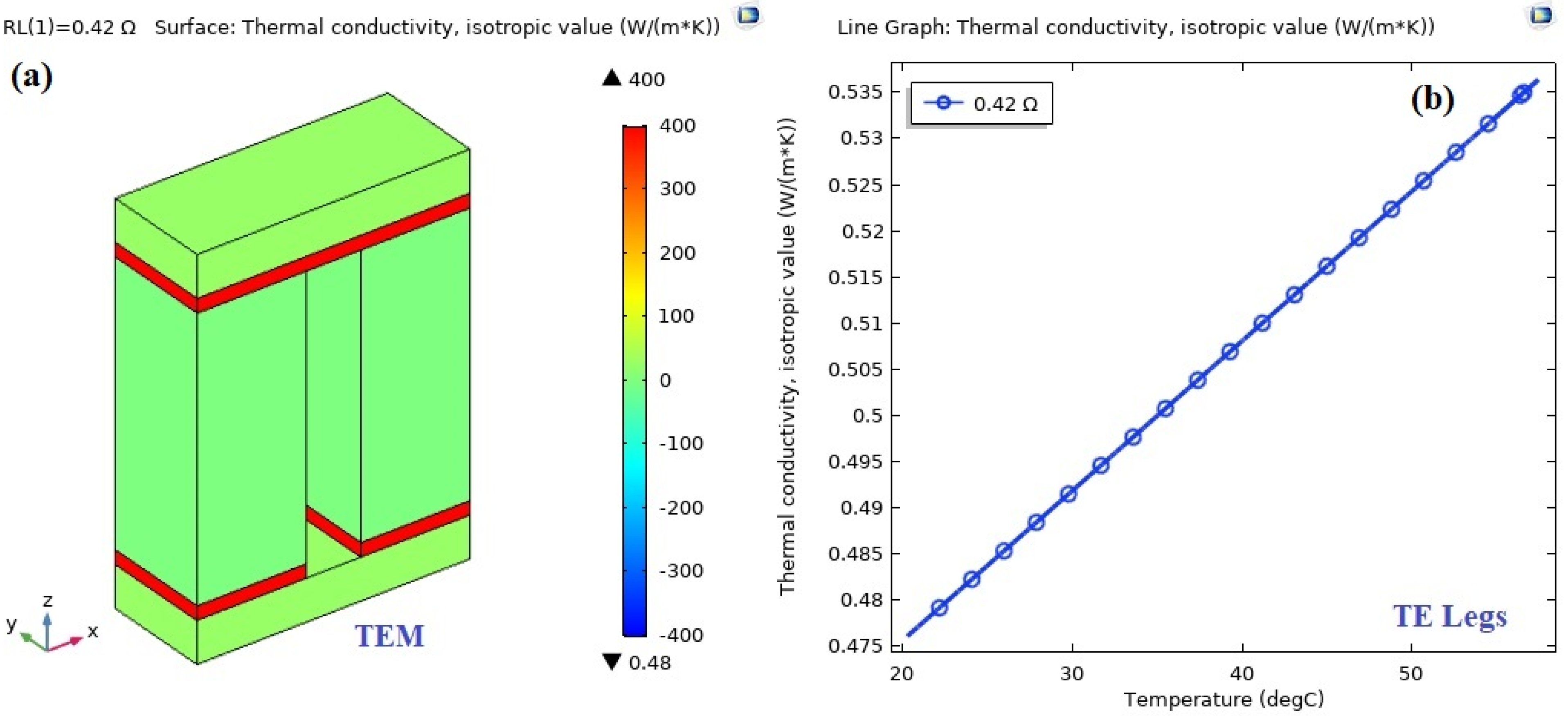

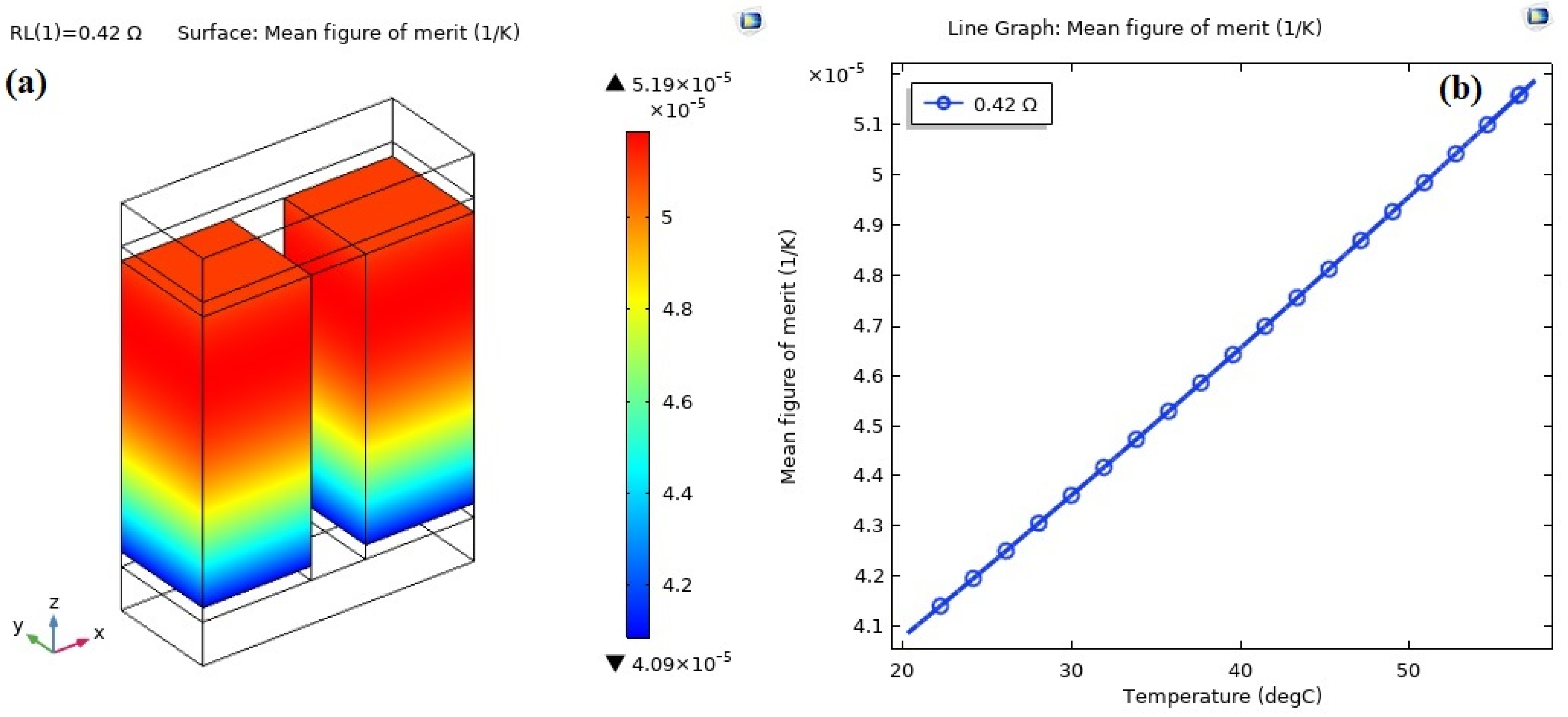
| Materials | Seebeck Coefficient S (V/K) | Thermal Conductivity k (W/(m×K)) | Electrical Conductivity σ (S/m) | Density ρ (kg/m3) | Specific Heat Capacity Cp (J/(kg×K)) |
|---|---|---|---|---|---|
| Al2O3 | 3.5 × 10−6 | 27 | 0.0 | 3900 | 900 |
| Cu | 6.5 × 10−6 | 400 | 5.998 × 107 | 8960 | 385 |
| P–type Bi2Te2.70Se0.30 | S (T) | k (T) | sigma (T) | 6.02 × 103 | Cp(T[1/K]) |
| N–type Bi2Te2.70Se0.30 | –S (T) | k (T) | sigma (T) | 6.02 × 103 | Cp(T[1/K]) |
Disclaimer/Publisher’s Note: The statements, opinions and data contained in all publications are solely those of the individual author(s) and contributor(s) and not of MDPI and/or the editor(s). MDPI and/or the editor(s) disclaim responsibility for any injury to people or property resulting from any ideas, methods, instructions or products referred to in the content. |
© 2024 by the authors. Licensee MDPI, Basel, Switzerland. This article is an open access article distributed under the terms and conditions of the Creative Commons Attribution (CC BY) license (https://creativecommons.org/licenses/by/4.0/).
Share and Cite
Hasan, M.K.; Üstüner, M.A.; Mamur, H.; Bhuiyan, M.R.A. Enhancing Bi2Te2.70Se0.30 Thermoelectric Module Performance through COMSOL Simulations. Thermo 2024, 4, 185-201. https://doi.org/10.3390/thermo4020011
Hasan MK, Üstüner MA, Mamur H, Bhuiyan MRA. Enhancing Bi2Te2.70Se0.30 Thermoelectric Module Performance through COMSOL Simulations. Thermo. 2024; 4(2):185-201. https://doi.org/10.3390/thermo4020011
Chicago/Turabian StyleHasan, Md. Kamrul, Mehmet Ali Üstüner, Hayati Mamur, and Mohammad Ruhul Amin Bhuiyan. 2024. "Enhancing Bi2Te2.70Se0.30 Thermoelectric Module Performance through COMSOL Simulations" Thermo 4, no. 2: 185-201. https://doi.org/10.3390/thermo4020011





